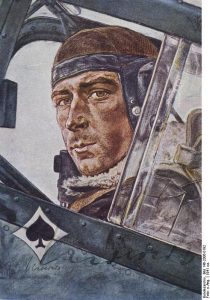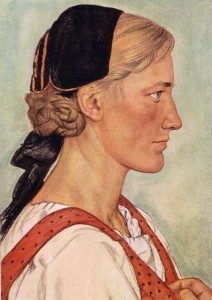To me, one of the most interesting aspects of studying Nazi Germany (and the Second World War in general) is the abundance of propaganda produced and distributed among the German people. Personally, I find Goebbels’ and Reifenstahl’s films to be the most fascinating form of propaganda under the Third Reich, but Moorhouse mentions several other aspects of propaganda as they relate to Berlin citizens specifically. Namely, the mass distribution of postcards and photographs of German “celebrities” or war heroes. In some ways, these items seemed almost more invasive than films or posters, as the material found its way into citizens’ daily lives, and onto the bedroom walls of many young and impressionable Hitler Youth members. The popularity of already established artist Wolfgang Willrich’s drawings came as no surprise, then, especially when he was portraying nearly every subject with the preferred aryan features.
Quite obviously, then, the goal of propaganda after the beginning of World War II was to control German public opinion (especially in the capital city) as much as possible. High morale would have been crucial in a total war that involved civilian populations as much as World War II would prove to. However, despite the distribution of propaganda, it seemed from the reading that, perhaps inevitably, Berlin’s atmosphere was determined exclusively by Germany’s progress in the war.
As an aside, it would be interesting to know the “life span” of these celebrities of Nazi Germany. For those who did not die in battle, did their fame last for more than a number of months? What happened to these war heroes upon the defeat of Germany?



Can you find any information about any of the war heroes? Many of the Nazis ended up being involved the in police and government of the various communist states–but plain war heroes may have had a different fate.